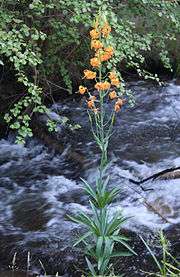Lilium columbianum
| Lilium columbianum | |
|---|---|
| | |
| Mount Baker-Snoqualmie National Forest | |
| Scientific classification | |
| Kingdom: | Plantae |
| (unranked): | Angiosperms |
| (unranked): | Monocots |
| Order: | Liliales |
| Family: | Liliaceae |
| Genus: | Lilium |
| Species: | L. columbianum |
| Binomial name | |
| Lilium columbianum Leichtlin 1871 not Hanson 1874 | |
| Synonyms[1] | |
|
Synonymy
| |
Lilium columbianum is a lily native to western North America.[2][3] It is also known as the Columbia lily or tiger lily (sharing the latter common name with several other lily species in its genus).


Distribution
Lilium columbianum occurs in lowland and montane forest openings and meadows from southern British Columbia in Canada south to northern California and east to Montana in the northwestern United States.[2][4] Mostly occurring below 2,000 m (6,600 ft), it usually blooms in June through early August.[2] There are a few isolated populations at high elevations in the Sierra Nevada as far south as Fresno County.[5][6]
Description
Lilium columbianum grows up to 1.2 metres (3.9 ft) tall, and bears from few to numerous orange flowers with darker spots. The tepals are 3 to 6 cm long and the flowers are lightly scented. Like many true lilies, the leaves are arranged in whorls around the stem of the plant.[7][8][9][5][10]
Uses
Food
Coast Salish, Nuu-chah-nulth and most western Washington peoples steamed, boiled or pit-cooked its bulbs. Bitter or peppery-tasting, they were mostly used as a flavoring, often in soup with meat or fish.[11]
Horticulture
From seed, Lilium columbianum requires three to five years to mature. Cultivated bulbs can be divided or bulb scales may be used to generate new plants more quickly. However, wild plants should be left undisturbed.[12]
References
- ↑ Kew World Checklist of Selected Plant Families
- 1 2 3 Sullivan, Steven. K. (2015). "Lilium columbianum". Wildflower Search. Retrieved 2016-04-09.
- ↑ "Lilium columbianum". PLANTS Database. United States Department of Agriculture; Natural Resources Conservation Service. 2015. Retrieved 2016-04-09.
- ↑ Biota of North America Program 2014 county distribution map
- 1 2 "Lilium columbianum". Jepson eFlora: Taxon page. Jepson Herbarium; University of California, Berkeley. 2015. Retrieved 2016-04-09.
- ↑ Calflora taxon report, Lilium columbianum Baker Columbia lily, Columbian lily, Oregon lily
- ↑ Flora of North America Vol. 26 Page 185 Lilium columbianum Leichtlin ex Duchartre
- ↑ Klinkenberg, Brian (Editor) (2014). "Lilium columbianum". E-Flora BC: Electronic Atlas of the Plants of British Columbia [eflora.bc.ca]. Lab for Advanced Spatial Analysis, Department of Geography, University of British Columbia, Vancouver. Retrieved 2016-04-09.
- ↑ Giblin, David (Editor) (2015). "Lilium columbianum". WTU Herbarium Image Collection. Burke Museum, University of Washington. Retrieved 2016-04-09.
- ↑ Hitchcock, C. Leo; Cronquist, Arthur (1973). Flora of the Pacific Northwest; an illustrated manual. Seattle: University of Washington Press. ISBN 0295952733.
- ↑ Pojar, Jim (2004). Plants of the Pacific Northwest Coast. Edmonton: Lone Pine Publishing. ISBN 9781551055305.
- ↑ Kruckeberg, Arthur R. (1996). Gardening with Native Plants of the Pacific Northwest: Second Edition. Seattle: University of Washington Press. ISBN 9780295974767.
External links
 Media related to Lilium columbianum at Wikimedia Commons
Media related to Lilium columbianum at Wikimedia Commons